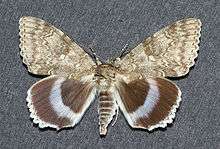Catocala fraxini
| Blue underwing | |
|---|---|
 | |
| Scientific classification | |
| Kingdom: | Animalia |
| Phylum: | Arthropoda |
| Class: | Insecta |
| Order: | Lepidoptera |
| Family: | Erebidae |
| Genus: | Catocala |
| Species: | C. fraxini |
| Binomial name | |
| Catocala fraxini (Linnaeus, 1758)[1] | |
| Synonyms | |
| |
Catocala fraxini, the blue underwing, also known as the Clifden nonpareil, is a moth of the Erebidae family.
Distribution
The distribution area covers almost the entire Central Europe and Northern Europe, as well as parts of southern Europe. The species is largely missing in Portugal, the Mediterranean islands (except Corsica), in Greece, in northern Scotland, in northern Scandinavia and North and in southern Russia. The distribution area stretches across the Palearctic to northern Turkey, Siberia, Russian Far East, Korea and Japan.
The name "Clifden nonpareil" is derived from the location of the first British records, at the Cliveden estate in Berkshire in the 18th century,[2] "nonpareil" meaning "without equal" in French.
Technical description and variation
Forewing whitish ochreous, irrorated with pale or dark grey, sometimes with a yellow tinge; inner and outer lines blackish, dentate, double; median and subterminal lines blackish, dentate; reniform stigma with black centre and outline; beneath it a pale yellowish diamond-shaped spot outlined with moerens. dark; hindwing blackish, with a broad blue postmedian band. — ab. moerens Fuchs has the forewing more or less strongly suffused throughout with blackish grey, obscuring the markings; — the form gaudens Stgr. on the other hand, from Central Asia, is very pale, with most of the black scaling obsolete; in the ab. contigua Schultz the pale spot below the reniform stigma is elongated outwards to touch the outer line, often, as well as the outer line itself, strongly yellow-tinged, especially noticeable in examples with the ground colour dark; -angustata Schultz is distinguished by the narrowness of the blue band of the hindwing; — the ab. maculata Kusenov shows a white mark at the lower angle of cell of hindwing. Schultz also records an instance of albinism in the forewings, where the grey scales throughout have become white,and the black lines brownish yellow, the hindwings remaining unaltered. [3]
Subspecies
- Catocala fraxini fraxini
- Catocala fraxini jezoensis Matsumura, 1931 (Japan)
- Catocala fraxini legionensis Gómez Bustillo & Vega Escandon, 1975 (Spain)
- Catocala fraxini yuennanensis Mell, 1936 (China: Yunnan)
Biology
Larva brownish grey, black speckled, with pointed prominences on segments 9 and 12. The caterpillars feed on various species of poplar.
References
- ↑ taxapad.com
- ↑ McCarthy, Michael (9 October 2013). "The holy grail of British moths is a real bolt from the blue". The Independent. Retrieved 5 October 2016.
- ↑ Seitz, A. Ed., 1914 Die Großschmetterlinge der Erde, Verlag Alfred Kernen, Stuttgart Band 3: Abt. 1, Die Großschmetterlinge des palaearktischen Faunengebietes, Die palaearktischen eulenartigen Nachtfalter, 1914
External links
| Wikimedia Commons has media related to Catocala fraxini. |
| Wikispecies has information related to: Catocala fraxini |